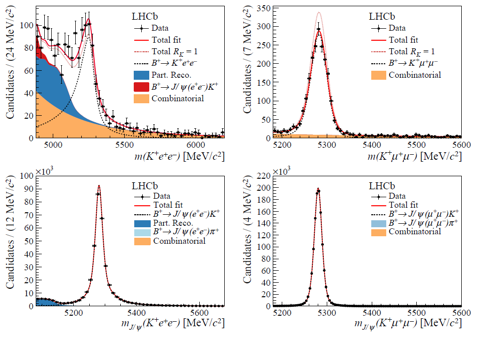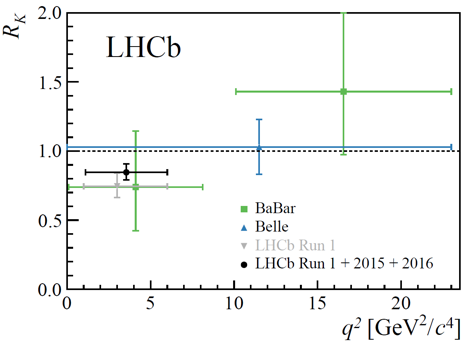Today at the Rencontres de Moriond EW conference, the LHCb Collaboration presented an updated measurement of the ratio RK, an important test of a principle of the Standard Model of particle physics known as “lepton universality“, which states that the Standard Model treats the three charged leptons (electrons, muons and taus) identically, except for differences due to their different masses.
The ratio RK describes how often a B+ meson decays to a charged kaon and either a muon and anti-muon pair (K+μ+μ–) or an electron and anti-electron pair (K+e+e–). These decays are extremely rare, occurring at a rate of only one in two million B+ meson decays. The decays involve the transformation of a beauty quark into a strange quark (b→s), a process that is highly suppressed in the Standard Model and can be affected by the existence of new particles, which could have masses too high to be produced directly at the Large Hadron Collider.
LHCb has studied a number of other such ratios comparing decays with different leptons in beauty particle decays (see RK, RK*0, R(D*) and R(J/ψ)). These results revealed hints of deviations from lepton universality, none of which was significant enough to constitute evidence of new physics on their own. However, according to theorists who study possible extensions of the Standard Model, taken together these deviations suggest an interesting and coherent pattern. All previous LHCb results used only the Run 1 data sample. During Run 2 (2015-2018), LHCb collected a much larger data sample containing approximately four times larger number of beauty particle decays and these data are now being analysed intensively. Measurements like RK use the technique of blind analysis, in which the physicists analysing the data do not know the result until the analysis method is finalized and frozen, following an extended review within the collaboration. The measurement presented today is the first lepton universality test performed using part of the Run 2 data set (2015-2016) together with the full Run 1 data sample, representing in total an integrated luminosity of 5fb-1.
To minimise the influence of detector and other experimental effects, LHCb physicists used a “double ratio” method: what they measure is RK divided by another ratio, rJ/ψ, the true value of which is known to be very close to 1 but which has similar sensitivity to detector effects to RK. This gives an extra layer of protection: the scientists study and correct for all known experimental effects, but if any unknown effects slip through they will cancel in the double ratio between RK and rJ/ψ. In more detail, RK is defined as the ratio of probabilities that a B+ meson decays to K+μ+μ– or K+e+e– (within a particular invariant mass range; see below), and rJ/ψ is defined as the ratio of probabilities that a B+ meson decays to J/ψK+ with J/ψ →μ+μ– vs J/ψK+ with J/ψ →e+e–. The double ratio method greatly reduces systematic uncertainties related to the different experimental treatment of muons and electrons, which largely cancel in the double ratio. In particular, the use of the double ratio method means that the detection efficiency of the decay B+→K+e+e– only needs to be known relative to that of the B+→J/ψ(→e+e–)K+ decay, rather than the B+→K+μ+μ–. Moreover, J/ψ meson decays into μ+μ– and e+e– pairs are known to respect lepton universality at the 0.4% level. This means that the measurement of the single ratio, rJ/ψ, also constitutes an excellent cross-check, since it does not benefit from the double ratio’s cancellation of systematic effects and so is a sensitive and stringent test of the methods used to determine the efficiencies. The value of rJ/ψ is found to be 1.014±0.035, consistent with 1. The figures show the measured invariant mass distributions of B+ candidates for the four decay modes used in the double-ratio measurement, each with a clear peak around the B+ meson mass.
The analysis is performed in the range 1.1<q2<6.0 GeV2, where q2 is the invariant mass of the μ+μ– and e+e– pair, and benefits from an improved reconstruction compared to the previous LHCb RK measurement. The value of RK is measured to be 0.846+0.060-0.054+0.016-0.014 , where the first uncertainty is statistical and the second systematic, and is shown at the image as a black point with error bars. This is the most precise measurement to date and is consistent with the SM expectation at the level of 2.5σ (2.5 standard deviations), a value very similar to the 2.6σ obtained in the previous measurement, and show as a grey point. The new measured value of RK supersedes the previous one, is closer to the Standard Model prediction, and has a smaller uncertainty. The result of BaBar Collaboration at low q2 is shown by the green left point and favors also a value below one. The blue point shows that the result of the RK measurement by the Belle Collaboration is consistent with one in the whole q2 range up to 22 GeV2. Further reduction in the uncertainty on RK can be expected when the data collected by LHCb in 2017 and 2018, which have a statistical power approximately equal to that of the entire 2011-2016 data set used here, are included in a future analysis. In the longer term, there are good prospects for even higher-precision measurements as much larger samples will be collected with the upgraded LHCb detector.
Read more in the LHCb Moriond presentation, in the LHCb paper and in the LHCb CERN seminar.



